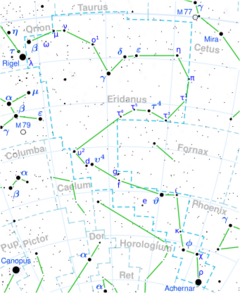Astronomy:HD 10647
| Observation data Equinox J2000.0]] (ICRS) | |
|---|---|
| Constellation | Eridanus |
| Right ascension | 01h 42m 29.3149s[1] |
| Declination | −53° 44′ 26.9912″[1] |
| Apparent magnitude (V) | 5.52[2] |
| Characteristics | |
| Spectral type | F9V[3] |
| B−V color index | 0.551[2] |
| Astrometry | |
| Radial velocity (Rv) | 12.9 km/s |
| Proper motion (μ) | RA: 165.832±0.099[1] mas/yr Dec.: −105.515±0.097[1] mas/yr |
| Parallax (π) | 57.6556 ± 0.0737[1] mas |
| Distance | 56.57 ± 0.07 ly (17.34 ± 0.02 pc) |
| Absolute magnitude (MV) | 4.32 |
| Details | |
| Mass | 1.11 ± 0.02[3] M☉ |
| Radius | 1.10 ± 0.02[3] R☉ |
| Luminosity | 1.41[3] L☉ |
| Temperature | 6,218 ± 20[3] K |
| Metallicity [Fe/H] | 0.00 ± 0.01[3] dex |
| Rotation | 10 ± 3[3] |
| Rotational velocity (v sin i) | 4.9[3] km/s |
| Age | 1.4 ± 0.9[3] Gyr |
| Other designations | |
| Database references | |
| SIMBAD | data |
| Extrasolar Planets Encyclopaedia | data |
HD 10647 (q1 Eridani) is a 6th-magnitude yellow-white dwarf star, 57 light-years away in the constellation of Eridanus. The star is visible to the unaided eye under very dark skies. It is slightly hotter and more luminous than the Sun, and at 1.75 billion years old, it is also younger. An extrasolar planet was discovered orbiting this star in 2003.
Planetary system
In 2003, Michel Mayor's team announced the discovery of a new planet, HD 10647 b, in Paris at the XIX IAP Colloquium Extrasolar Planets: Today & Tomorrow* [1]. The Anglo-Australian Planet Search team initially did not detect the planet in 2004,[4] though a solution was made by 2006.[5] The CORALIE data was finally published in 2013.[3]
The IRAS infrared space telescope detected an excess of infrared radiation from the star, indicating a possible circumstellar disk.[6] Out of the 300 nearest Sun-like stars, the disk has the highest fractional luminosity out of all of them.[7] It is unusually bright, but not unusually massive; the lower bound of the mass is 8 times that of the Earth.[7]
The inclination of the disk is relatively high,[8] and the disk is asymmetrical, being more extended in the northeast direction than the southwest.[7] It extends from 34 astronomical units (AU) at the inner edge to 134 AU at the outer edge. The inner edge is sharp, suggesting the existence of a planet that carved out the edge. HD 10647 b, with a semimajor axis of about 2 AU, is too far to be responsible. However, other potential planets may be responsible for this feature.[7]
There is some evidence for an additional, warm asteroid belt-like component further in, at 3 to 10 AU away from the star.[7]
| Companion (in order from star) |
Mass | Semimajor axis (AU) |
Orbital period (days) |
Eccentricity | Inclination | Radius |
|---|---|---|---|---|---|---|
| b[3] | >0.94 ± 0.08 MJ | 2.015 ± 0.011 | 989.2 ± 8.1 | 0.15 ± 0.08 | — | — |
| Dust disk[7] | 3–10 AU | — | — | |||
| Dust disk[7] | 34–134 AU | 76.1 ± 1.0° | — | |||
References
- ↑ 1.0 1.1 1.2 1.3 1.4 Brown, A. G. A. (August 2018). "Gaia Data Release 2: Summary of the contents and survey properties". Astronomy & Astrophysics 616: A1. doi:10.1051/0004-6361/201833051. Bibcode: 2018A&A...616A...1G. Gaia DR2 record for this source at VizieR.
- ↑ 2.0 2.1 Decin, G. et al. (November 2003), "Age Dependence of the Vega Phenomenon: Observations", The Astrophysical Journal 598 (1): 636–644, doi:10.1086/378800, Bibcode: 2003ApJ...598..636D
- ↑ 3.00 3.01 3.02 3.03 3.04 3.05 3.06 3.07 3.08 3.09 3.10 Marmier, M. et al. (2013). "The CORALIE survey for southern extrasolar planets XVII. New and updated long period and massive planets". Astronomy and Astrophysics 551: A90. doi:10.1051/0004-6361/201219639. Bibcode: 2013A&A...551A..90M. https://www.aanda.org/articles/aa/full_html/2013/03/aa19639-12/aa19639-12.html.
- ↑ Jones, H. R. A. (2004). "HD10647 and the Distribution of Exoplanet Properties with Semi-major Axis". Extrasolar Planets: Today and Tomorrow 321: 298. Bibcode: 2004ASPC..321..298J.
- ↑ Butler, R. P. et al. (2006). "Catalog of Nearby Exoplanets". The Astrophysical Journal 646 (1): 505–522. doi:10.1086/504701. Bibcode: 2006ApJ...646..505B.
- ↑ Stencel and Backman; Backman, Dana E. (1991). "A survey for infrared excesses among high galactic latitude SAO stars". The Astrophysical Journal Supplement Series 75: 905–924. doi:10.1086/191553. Bibcode: 1991ApJS...75..905S.
- ↑ 7.0 7.1 7.2 7.3 7.4 7.5 7.6 Lovell, J. B.; Marino, S.; Wyatt, M. C.; Kennedy, G. M.; MacGregor, M. A.; Stapelfeldt, K.; Dent, B.; Krist, J. et al. (2021). "High-resolution ALMA and HST images of q1 Eri: An asymmetric debris disc with an eccentric Jupiter". Monthly Notices of the Royal Astronomical Society 506 (2): 1978–2001. doi:10.1093/mnras/stab1678.
- ↑ Liseau et al. (2008). "q1 Eridani: a solar-type star with a planet and a dust belt". Astronomy and Astrophysics Letters 480 (3): L47–L50. doi:10.1051/0004-6361:20079276. Bibcode: 2008A&A...480L..47L. http://www.aanda.org/articles/aa/full/2008/12/aa9276-07/aa9276-07.html.
External links
- "A Jovian planet around HD 10647". Geneva Observatory. http://obswww.unige.ch/~udry/planet/hd10647.html.
- "HD 10647 / HR 506 / CP(D)-54 365 (q1 Eridani)". SolStation. http://www.solstation.com/stars2/hd10647.htm.
- Sky Map: HD 10647
Coordinates: ![]() 01h 42m 29.32s, −53° 44′ 27.00″
01h 42m 29.32s, −53° 44′ 27.00″
 |


